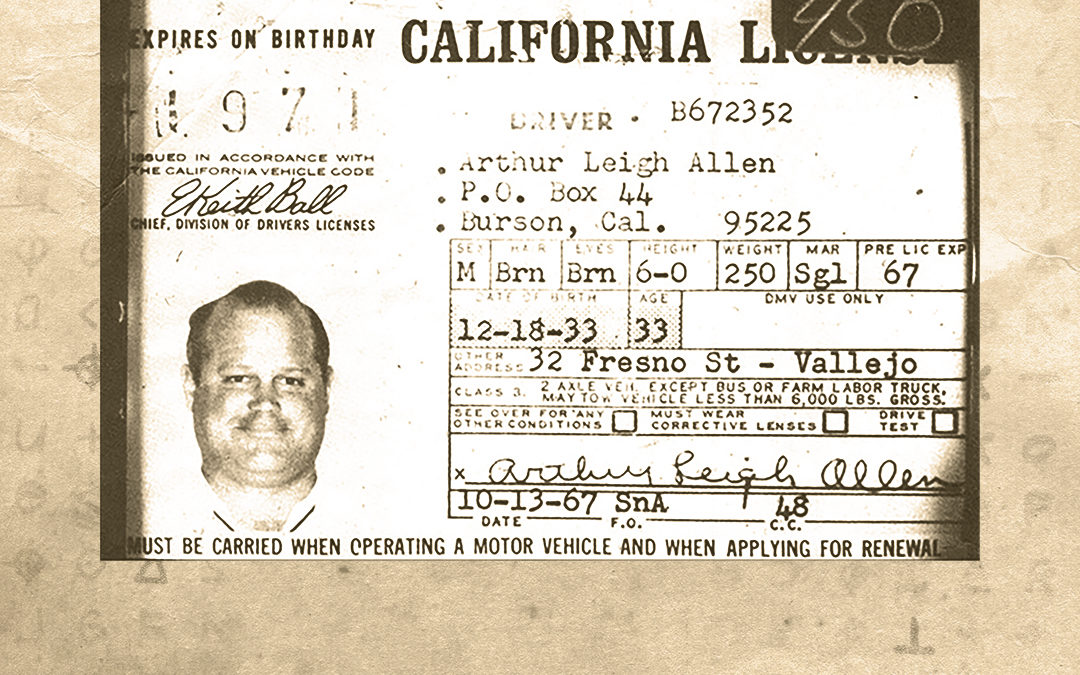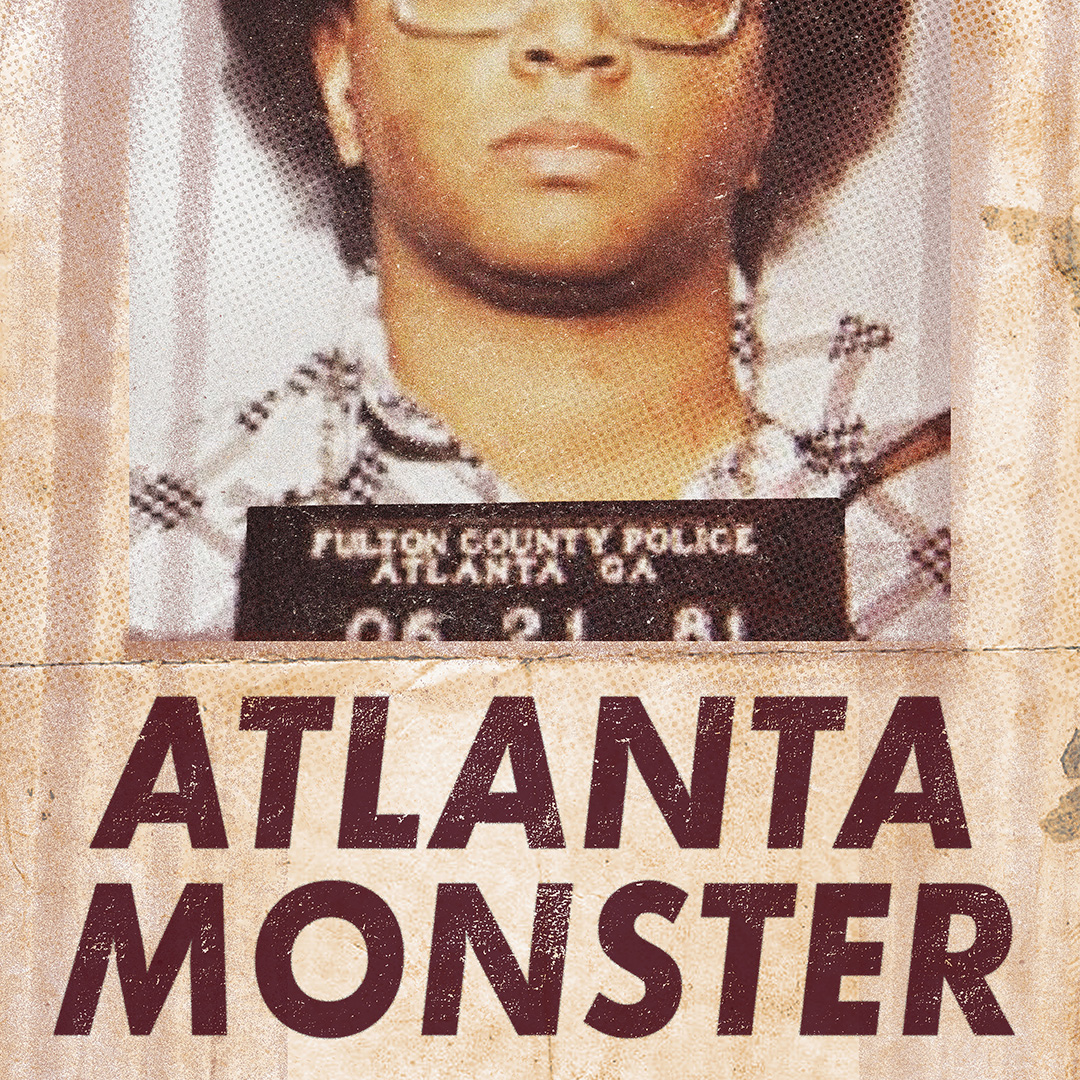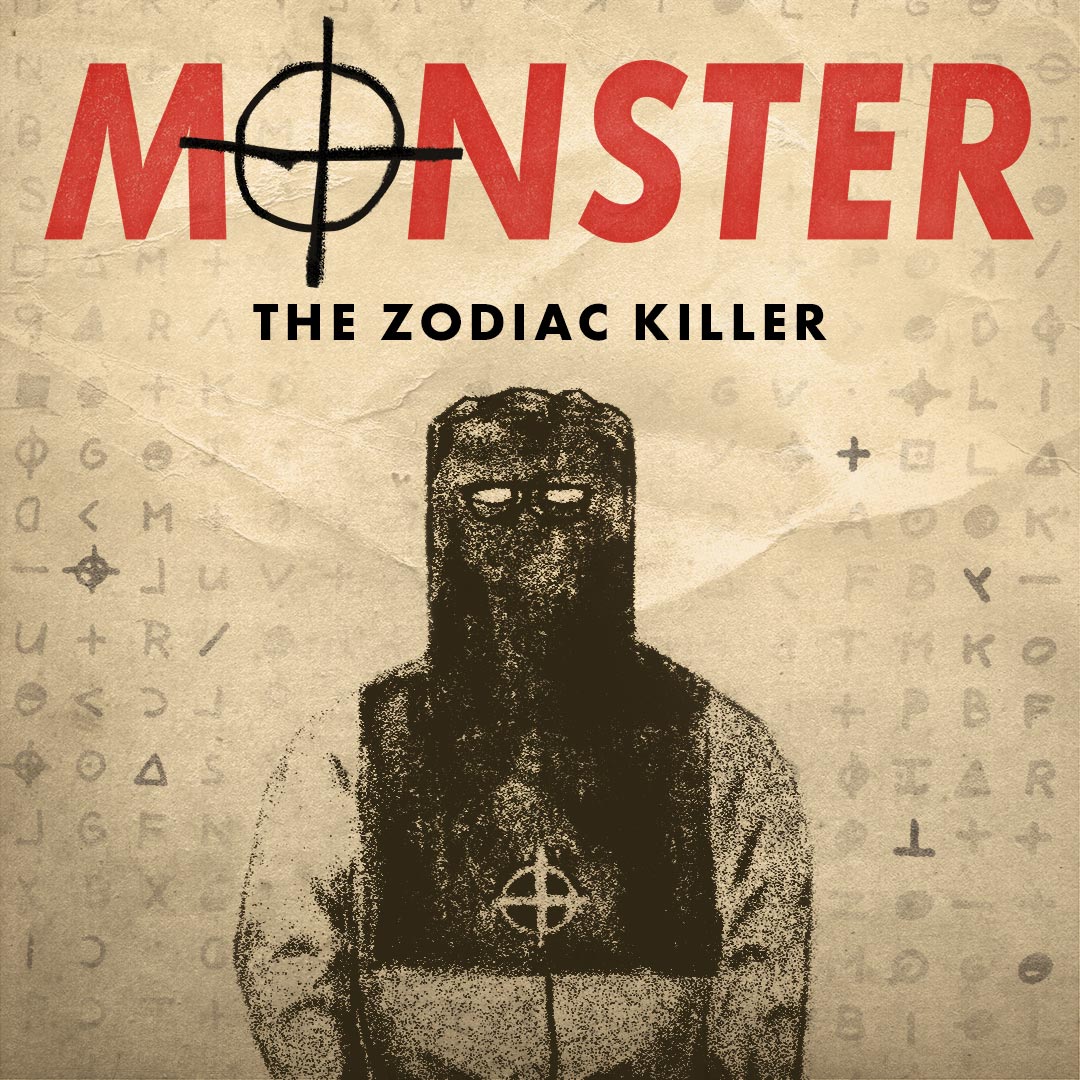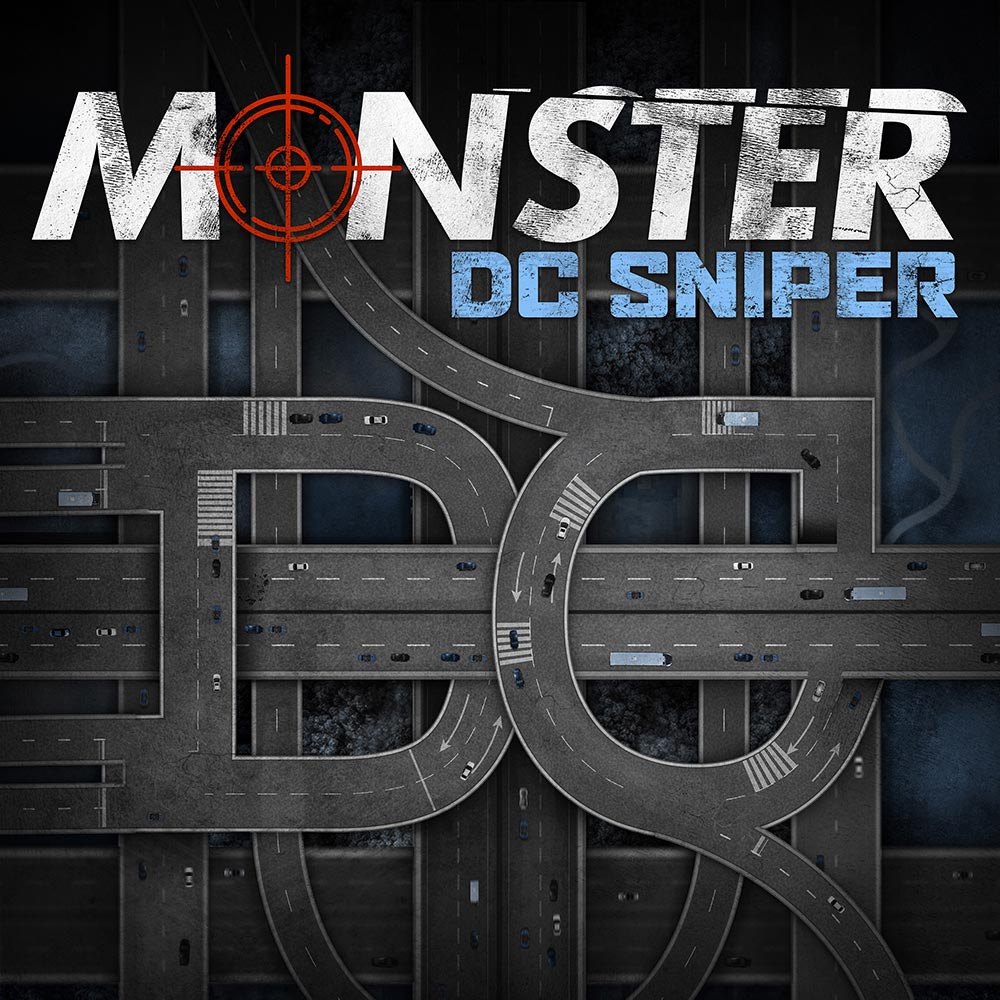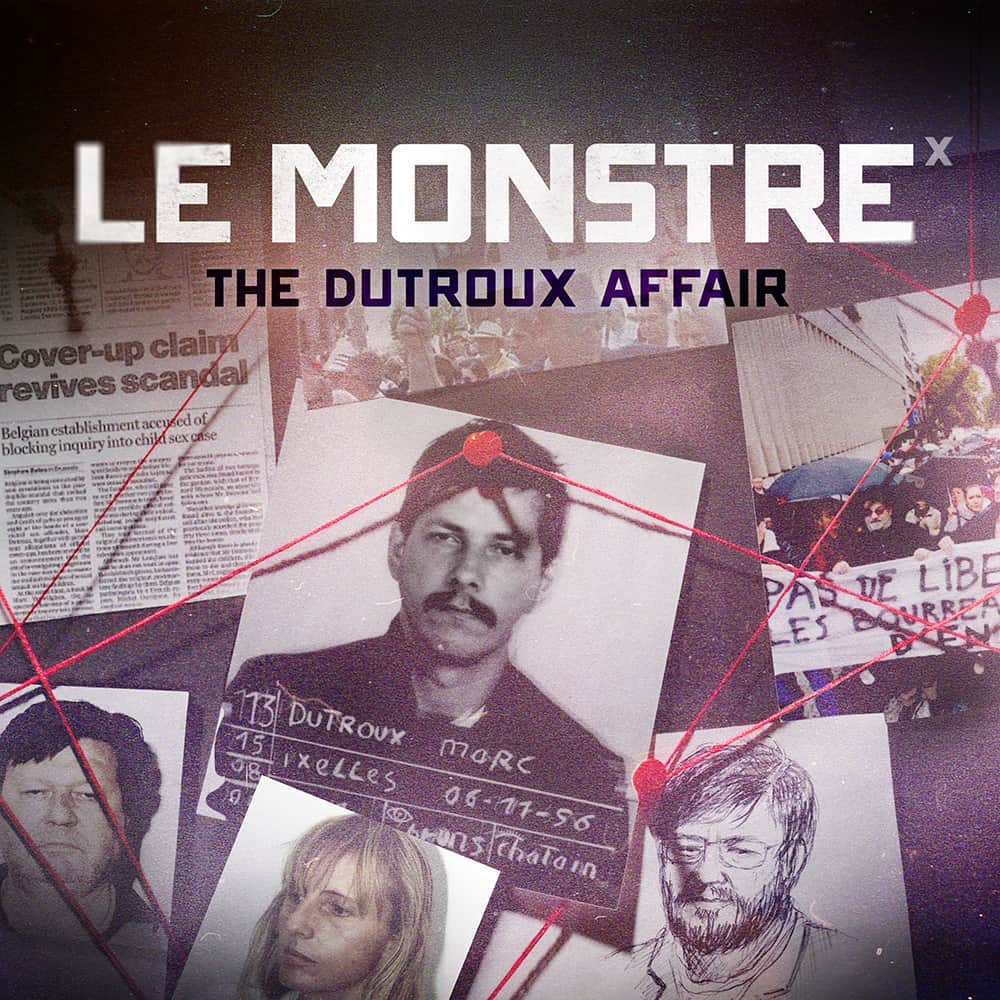9 • The Prime Suspect
Investigators finally put a name and face to the Zodiac. The prime suspect is revealed.
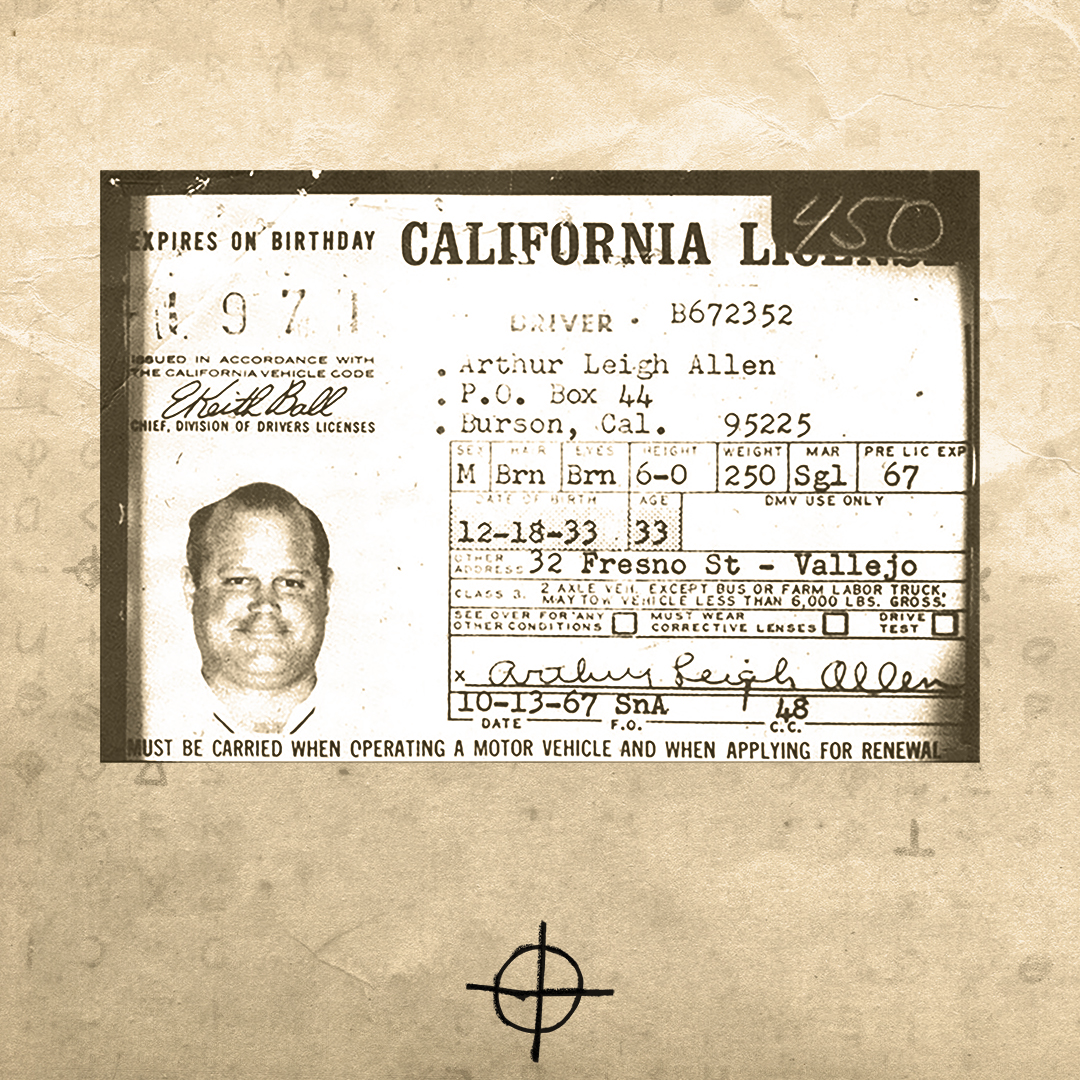
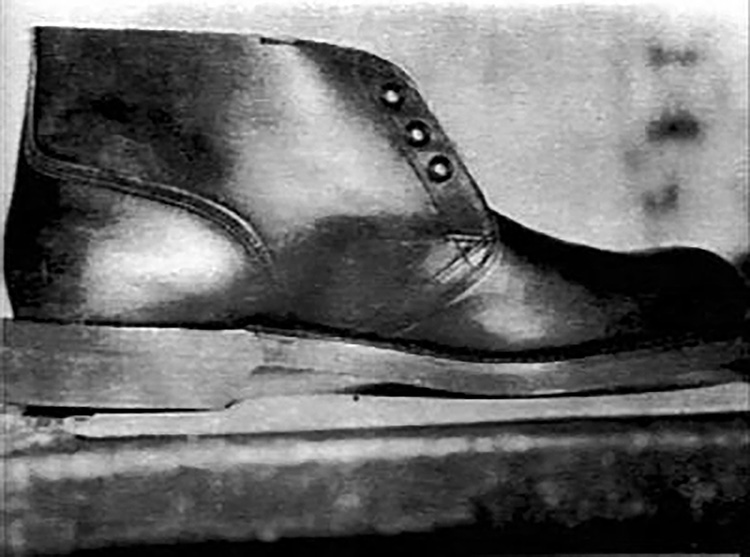
It was just weird to think that I knew the guy as a kid…It certainly seems plausible that he could have been the guy.
– Mark Uebner, his family knew Arthur Leigh Allen
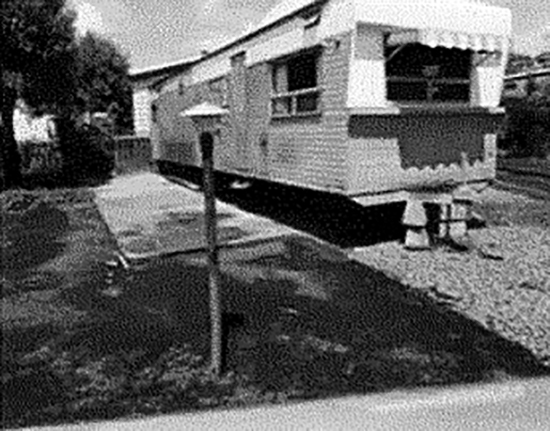
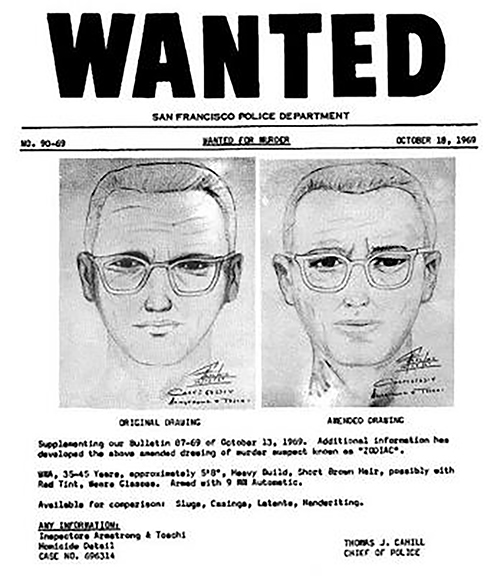
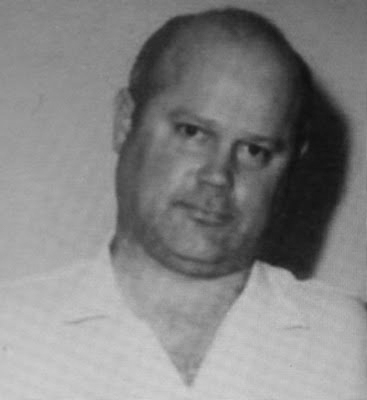
He was a little shaky in his denials that he was the Zodiac. He was eager to talk a lot.
– Kevin Fagin, San Francisco Chronicle journalist
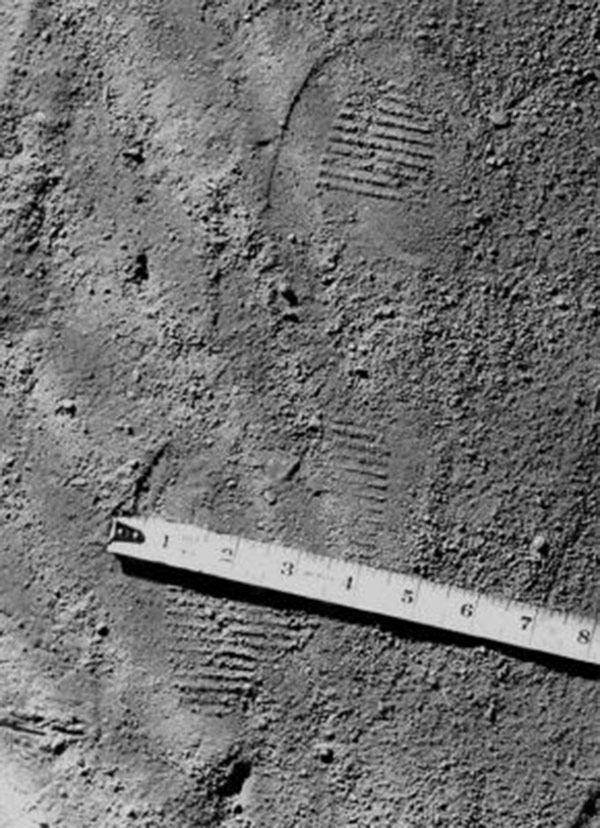
Allen’s shoe size matched the Zodiac’s bootprint from Lake Berryessa.
Transcript
Speaker 1: The views and opinions expressed in this podcast are solely those of the podcast author, or individuals participating in the podcast, and do not necessarily represent those of iHeart Media, How Stuff Works or its employees.
Speaker 2: Zodiac, a symbol that now stands for terror in San Francisco. Today, there was a possibly significant development in the terrifying case of the man who calls himself Zodiac and has boasted that he is responsible for five murders in the last nine months. In Zodiac’s latest letter last week he threatened to make a busload of school children his next victims. Since then, school buses have been discretely guarded, and parents fears have openly risen. This morning, the people of San Francisco, during a television conversation program with Attorney Melvin Belli, heard a man who claimed to be Zodiac talking on the air.
Speaker 3: A man in a mask robbed, tied and stabbed them, leaving them for dead.
Speaker 4: Subject stated, “I want to report a murder. No, a double murder. I did it.”
Speaker 5: A man who wore a medieval-style executioners hood, carried a knife and gun and intended to use them.
Speaker 6: They haven’t arrested me because they can’t prove a thing. I’m not the damn Zodiac.
Speaker 7: Who is the Zodiac and where is he?
Host: The views and opinions expressed in this podcast are solely those of the podcast author or individuals participating in the podcast and do not necessarily represent those of iHeart Media, How Stuff Works, or its employees.
Female: Robert Graysmith is the author of a book called Zodiac. What happens 33 years later when you still don’t have the killer? Are there still people working on this case? Are there still tips coming in? Anything to this investigation?
Robert G.: Absolutely. You know, we’re pretty certain we know who he was, and he died with bombs in his basement and the Zodiac bomb formula, a disc in his computer that said Zodiac. I’m pretty sure that the case is solved. So much information and so much attention were focused on the prime suspect in the case, the man who actually was the first suspect, who knew all the victims, who stalked them, who had the skills and intelligence to write the letters and to commit the crimes was literally stopped dead in his tracks. He was watched, eventually sent to prison for child molesting during which there were no more activities from the Zodiac.
Host: The suspect that was focused on and highlighted in the film and in Graysmith’s book, and to a certain extent even for Toschi and Armstrong, Arthur Leigh Allen was what they call a good suspect.
Male: It’s probably Arthur Leigh Allen. That was what all the main guys investigating here though. They think Arthur Leigh Allen was the guy.
Arthur Leigh A.: I enjoy a good tussle, but hey, there were coincidences that tended to point towards me and killing just for the pleasure of it. Thank God for our Constitution, because that says a person is innocent until proven guilty.
continue reading
Male: A man in a mask robbed, tied, and stabbed them, leaving them for dead.
Male: The subject stated, “I want to report a murder. No, a double murder. I did it.”
Male: The man who wore a medieval-style executioner’s hood carried a knife and gun and intended to use them.
Arthur Leigh A.: They haven’t arrested me because they can’t prove a thing. I’m not the damn Zodiac.
Male: Who is the Zodiac and where is he?
Host: From iHeart Radio, How Stuff Works, and Tenderfoot TV, this is Monster: The Zodiac Killer. The Zodiac case is rife with mystery; first and foremost, the Zodiac’s true identity. Up to this point, there had only been vague glimpses of the man behind the moniker. Witness descriptions were cloudy. He was only ever seen in the dark of night or behind a terrifying costume. We heard a strange voice call into a TV show, but it wasn’t actually the Zodiac. So who was this guy? For years, it seemed like there would never be an answer, but then a name, a face, and a voice were finally attached to the Zodiac. Publicly, one man became the most visible and likely suspect.
Michael B.: One of the prime suspects in the Zodiac case over the years was a man who was initially identified for reasons we don’t know, in October of 1969.
Host: This is Zodiac expert Michael Butterfield.
Michael B.: Arthur Leigh Allen was a former schoolteacher who was working as a janitor, largely because he had been caught molesting children and had lost his job. For some reason, John Lynch of the Vallejo Police Department went and questioned Arthur Leigh Allen, and on October 6th, 1969, regarding his whereabouts at the time of the stabbing at Lake Berryessa. Allen said that he was at Salt Point Ranch and he had killed some chickens and that he didn’t have any involvement in the crime.
Host: Salt Point is about 90 miles west of Lake Berryessa. It’s close, but not close enough, and with no direct evidence linking him to the murder, Allen was let go.
Michael B.: After that, the police forgot about Arthur Leigh Allen. Then in 1971, an estranged friend of Allen’s went to police and said that prior to the Zodiac murders, Arthur Leigh Allen had professed his desire to kill people and write letters to the media calling himself Zodiac. The police investigated, the Vallejo Police and the San Francisco Police, including Bill Armstrong and Dave Toschi, spend about two weeks investigating Arthur Leigh Allen and gathering information, talking to people who knew him, including his brother and sister-in-law, and the individual who made this claim, Don Cheney.
Don Cheney was first friends with Arthur Leigh Allen’s brother, Ron, and that’s how he got to know Arthur Leigh Allen or who was normally referred to as Leigh. They became friends. They would hunt and fish and drink together and do things, but then at a certain point, it appears that Arthur Leigh Allen attempted to molest one of Don Cheney’s children. Don Cheney complained to Leigh’s brother, Ron, and was adamant that something had happened and he was very upset about it. And he apparently severed his relationship with Arthur Leigh Allen at that time. According to Cheney’s timing of events, this occurred sometime in 1968, the last time he had ever talked to Arthur Leigh Allen.
Host: According to Vallejo PD detective, George Bawart, Allen told Cheney he wanted to write a novel, and in this novel, a character would do the following things: kill random couples, taunt police with letters recounting his crimes, wear makeup to disguise himself, secure a flashlight to his gun so he could shoot in the dark, call himself Zodiac. Cheney was questioned again about this story years later, and these new details were recorded by Detective Bawart. Cheney recalled that Allen was gifted a Zodiac brand watch by his mother, and on the face of this watch there was a symbol, a circle with a cross through it. Cheney said Allen wanted to sign letters with the same cross-circle symbol from his watch. Cheney also claims that Allen wanted to fool women into stopping their cars in isolated areas. He would claim they had problems with their tires, then loosen their lug nuts and take them captive.
Shortly after this, investigators learned of a connection to Darlene Ferrin, who was shot and killed by the Zodiac at Blue Rock Springs. As it turns out, Allen’s family home was just a fraction of a mile away from the restaurant where Darlene worked, and Allen supposedly said he’d become friendly with a waitress at that restaurant. Police records say an unidentified man named Leigh often visited Darlene, so it’s possible Allen was stalking Darlene.
Michael B.: There was also a story that Arthur Leigh Allen may have used a friend’s car to commit the murder at Blue Rock Springs because the surviving victim said that the killer was driving a car similar to Darlene’s brown Corvair. Allen was working at a gas station where a friend of his had apparently put a car up for sale, and the theory was that he had taken the car and committed the crime because Allen did not own a Corvair or any vehicle similar to one.
Eventually, in 1972, the San Francisco Police Department obtained a warrant to search Arthur Leigh Allen’s trailer in Santa Rosa, California.
Host: On September 14th, 1972, San Francisco Police obtained a warrant and searched Allen’s trailer. Here’s a partial list of what police were looking for: writings, letters and cryptograms in the same handwriting as suspect letters, any pistol with a flashlight attached to the barrel, a blood-stained portion of cloth from a striped gray and white shirt, the wallet or identification of Paul Stein, taxi keys from Yellow Cab, a black executioner type hood with a circle and cross on it, a large knife with a wooden handle.
Michael B.: They did find some oddities in his home like dead squirrels in his refrigerator that he was using for his biology classes, some sex toys, guns, things like that.
Host: Investigators found many bizarre things, but they didn’t find any of the materials they were looking for, so they had no hard evidence to use against Allen. They did, however, obtain his fingerprints and samples of his writing. Those were thoroughly cross-examined with the Zodiac letters.
Michael B.: And that’s when they learned that his fingerprints and handwriting didn’t match, so essentially Arthur Leigh Allen was abandoned as a suspect.
Host: Yet again, Arthur Leigh Allen was let off the hook. Despite some suspicious activity, Allen was in the clear, until …
Michael B.: Years later, a best-selling book came out called Zodiac, written by Robert Graysmith.
Robert G.: I still talk to the investigators on the case. Inspector David Toschi, who was the main man on the case, he believes it was Arthur Leigh Allen. The main man in Vallejo, George Bawart, who is retired now, he thinks it was Arthur Leigh Allen. Virtually all of the top investigators, men who I really respect, believe that this was the man.
Host: That was Robert Graysmith. In the early ‘70s, he was a political cartoonist at the San Francisco Chronicle. Graysmith developed an obsession with the Zodiac case, and so he was doing his own private investigation. In 1986, Graysmith published a book containing his complete findings on the case. It was simply titled Zodiac, and it went on to sell over three million copies.
Michael B.: And in that book, Graysmith had given Arthur Leigh Allen the pseudonym Bob Hall Starr. A lot of people started to figure out that Arthur Leigh Allen was Bob Hall Starr. People in the Bay area realized he was the person they were talking about, and that book, of course, because it was a best-selling book, had a tremendous influence on the public and the media.
Male: Arthur Leigh Allen, a longtime Vallejo resident and former professional student-
Speaker 1: A long time Vallejo resident and former professional student is the man many still believe to be the dreaded Zodiac. In Robert Graysmith’s best selling book Zodiac, the suspect’s brother and sister-in-law say that Allen often spoke of man as the most dangerous game. His own family at one time found him terrifying.
Host: Graysmith connected many dots between Arthur Leigh Allen and the Zodiac. One of which is that Allen was allegedly in Riverside when Cheri Jo Bates was murdered in 1966. The Vallejo Police Department had placed him in the area, and when questioned, Allen said he was in nearby Pomona during the Bates murder. He also called in sick from his job on November 1st, the day after Bates was found dead. It’s possible Allen missed work to hide facial wounds inflicted by his victim. You may also remember that Zodiac left behind a footprint at Lake Berryessa. That footprint was made by a military boot. This suggested the Zodiac had some military experience.
Arthur Leigh Allen had numerous connections to the military. His father was the commander of a nuclear submarine at nearby Mare Island. Allen himself was in the Navy for less than two years before being discharged other than honorably. While there, Graysmith believes Allen developed an interest in codes and ciphers. Much of this is hearsay. The Zodiac book laid out one undeniable mark against Allen. Graysmith points out that the last official Zodiac letter came on July 8th, 1974. Only a few months later, Allen would go to prison on child molestation charges. During Allen’s time in prison, there were no Zodiac letters.
Then, in 1978, just months after Allen was released, a new letter showed up at the San Francisco Chronicle.
Speaker 2: Dear editor. This is the Zodiac speaking. I’m back with you. I’m waiting for a good movie about me. Who will play me? I am now in control of all things. Yours truly, Zodiac guess. San Francisco Police Department.
Host: It’s important to note here that this letter was never authenticated. We’ll get into that in a later episode. Still, many investigators found this coincidence to be striking. Graysmith built a massive case of circumstantial evidence against Arthur Leigh Allen, and it was enough to convince a lot of readers of his guilt. Was Allen truly the villain Graysmith made him out to be or was Allen just an incredibly strange individual? We asked someone who knew Allen personally.
Carl Uebner: He had a few chipmunks at his house. One time he came in the shop after he had a job up in the foothills and he carried one around on his shoulder, and I think that was from when he worked up in the hills where he said, “Come on up, and I’ll show your kids how to sail.”
Host: This is Carl Uebner. He ran a blacksmith shop in downtown Vallejo. Arthur Leigh Allen came by frequently.
Carl Uebner: He came down to Vallejo and came into the shop and said, several times in fact, “Why don’t you bring the kids up, and I’ll teach them sailing?” I said to him, “Well, we’ve got to do that sometime,” but we never did. Then I found out he was canned anyway, and that ended that. So no, I never did go up there.
Host: We also talked with Mark Uebner, Carl’s son. At the time, he was just a kid.
Mark Uebner: When I heard that story, my first reaction was he certainly wouldn’t mess with the kids of a friend of his. I’d be surprised.
Carl Uebner: I knew Arthur Leigh Allen in school. He was a half a grade behind me, but we knew each other, and then, later on, he would come into the shop once and a while. He worked on his car, so we did blacksmith work. We made things like gates, railings. We’d roll something up for him. Leigh Allen at the time worked at ACE Hardware down half a dozen blocks from the shop on Tennessee Street.
Host: Eventually Mark and Carl started interviewing each other, and Mark had a lot of questions for his dad.
Mark Uebner: What about when we had the rear end done?
Carl Uebner: With one instance, you know what a rear end is on the car? In old cars. They’re pretty heavy, so we did some work on it. He came and picked it up, and he just grabbed it and threw it up over his head and walked out, and one of the guys kind of shook his head and, “What the heck?” I don’t think it was so much that he was so strong, it was just odd that he did it that way. Most guys wouldn’t do that, but he was a pretty strong guy.
He had come in one time and said, “Hey, I have this letter.” It said that he was no longer a suspect in the Zodiac case.
Mark Uebner: I was thinking about this earlier. So, when he came in with the letter. Was he just saying, “Here’s the letter, I’m exonerated,” or just, “Carl, trust me, man? This isn’t me.” I’m wondering if he was emphatic at all, or just blasé about it.
Carl Uebner: No, he was just, I wouldn’t say blasé, but he just came in and said, “Hey, I’ve got something to show you,” or whatever. He said, “Here’s the letter from the Sonoma County Sheriff that says I’m not a suspect anymore.”
Mark Uebner: Yeah.
Carl Uebner: Whatever the wording was, that I’m not a suspect anymore.
Mark Uebner: Because I think he also told me once that he needed that letter because he couldn’t get a job. He had to have that letter so he could go apply for a job.
Carl Uebner: Yeah. He didn’t have to show the letter, but he did if it ever came up and said, “Hey look.” I think a lot of people were a little bit leery of him probably, after that. As as far as I know, he did not have a girlfriend. He never mentioned it, and I’ve never seen them before. He was a loner in that respect. I don’t want to describe him as a loner, but I don’t know, but he did have friends I guess. I never really seen him with anybody. He’s always by himself.
Mark Uebner: Let me just … I’m curious. So, if you saw his name in the paper or saw his name in the news, what did you think? Like, “Hey, that’s my friend.”
Carl Uebner: Yeah, yeah. We weren’t qualified as friends. We were-
Mark Uebner: Yeah, buddies.
Carl Uebner: I knew him from school and a little bit after school. Yeah, we were friendly and on good terms.
Mark Uebner: Did you ever think he did it?
Carl Uebner: It ran through my mind of course, yeah.
Mark Uebner: Yeah, it was just weird to think that I knew the guy as a kid. I knew my dad knew him. It’s one of those things that I would love to know what the real answer is. I would love to know if it was him. I’ve seen other suspects’ name, but obviously, the only one that is in my head is Leigh Allen. I certainly believe he could have been. I mean again, I didn’t know him as my dad, but just all the stuff I’ve read and seen about him, it seems plausible. I’d say that. It certainly seems plausible that he could have been the guy.
Michael B.: In December of 1990, another individual from Arthur Leigh Allen’s past, another person who he had a falling out with, came forward and claimed that shortly before the Zodiac murdered cab driver Paul Stine, Arthur Leigh Allen had professed his desire to kill a cab driver and claimed that he was the Zodiac. This was Ralph Spinelli, who was a career criminal. He had been arrested for several charges of armed robbery and was probably facing the rest of his life in prison, and he approached authorities asking to make a deal. He didn’t want to go to prison, and in exchange, he would name Allen as the Zodiac.
Host: By the time Spinelli came forward, the Graysmith book had been out for years. Allen’s involvement in the Zodiac case was now public, and with this new testimony pointing at Allen, investigators once again took him seriously as a suspect.
Michael B.: The Vallejo Police Department relaunched their investigation of Arthur Leigh Allen in 1991. The Vallejo Police Department consulted the FBI, and a profiler told them that if Allen was indeed the Zodiac, it was likely he still had some trophies or belongings from the victims and the crimes. They got another search warrant for his home, and the news broke in the media.
Host: Here’s a partial list of what police found in Allen’s home in 1991. Four pipe bombs, a Ruger .22 caliber revolver, a Zodiac brand watch, news clippings about the Zodiac case, a large hunting knife, a small flashlight, a Royal manual typewriter. This typewriter had an important connection. The letters claiming responsibility for the murder of Cheri Jo Bates were made by a Royal model typewriter. There were some things the police were able to determine at this point. Allen’s shoe size matched the Zodiac’s bootprint from Lake Berryessa. Both used large knives, and both used the same guns and the same type of ammunition. Allen’s home was searched several more times after this, and they found even more suspicious objects, but they never found anything that directly linked him to the Zodiac murders. For the third time, Arthur Leigh Allen was exonerated. At least officially.
Kevin Fagan: Well, good cops have instincts, and when talked to Allen, he creeped him out. He thought he had a live one. That counts for a lot in an investigation.
Host: This is San Francisco Chronicle journalist Kevin Fagan. He’s the current reporter assigned to the Zodiac case. As part of that role, he’s talked with-
Host: … Zodiac case. As part of that role he’s talked with all the lead investigators and journalists involved in the story, and he knows more about the prime suspect than just about anybody else. We went to Kevin Fagan to understand what investigators finally concluded about Allen.
Kevin Fagin: Everyone who went to that house came away feeling, “Wow, this might well be the guy.” He was a little shaky in his denials that he was the Zodiac. He was eager to talk a lot.
Speaker 3: This is the Vallejo man many investigators consider to be the notorious Zodiac Killer, and this is the first time his picture has been revealed. His name is Arthur Leigh Allen.
Are you the Zodiac Killer?
Arthur Allen: There would be nothing farther from my mind. No, I’m most certainly not the Zodiac Killer.
Kevin Fagin: He just came off like a possible guy, you’d get a tingle, and that’s what I heard from everyone who talked to him back in the day. Allen has been the only one named directly as a suspect by any of the investigators. And he cropped up through Dave Toschi, he was the main homicide inspector in San Francisco who was working the case actively during the height of the Zodiac craze. He kept going back to Allen, year after year after year. But he’s been the guy for a lot of investigators.
Roy Conway: There are so many lies I caught him in, it’s his denying things didn’t have any relevance anymore.
Kevin Fagin: That was Vallejo PD Captain Roy Conway talking about Allen. Vallejo PD Detective George Bawart also spoke about Allen’s guilt.
George Bawart: I feel that there are so many areas that point directly at Arthur Leigh Allen that I feel he is a viable suspect and in all probability the Zodiac.
Kevin Fagin: Allen had a lot of aspects that tied him to the crimes. He owned boots identical to the Zodiac according to the prints taken at the scenes. His favorite short story was The Most Dangerous Game, and the Zodiac in one of the letters talked about how he loved to hunt humans because they’re the most dangerous game. It wasn’t that obscure a story at the time, but it wasn’t on everyone’s mind. The fact that Allen mentioned that and the fact that it got mentioned in the letter raises your eyebrows pretty high. He was picked out in a photo lineup by one of the victims, and he wore a watch that had Zodiac crosshairs on it. A lot of things matched. He looked like the sketch.
Host: And remember investigators also had the testimony of Don Cheney, an old friend of Allen’s.
Kevin Fagin: Yeah, Cheney had conversations with Allen that disturbed him. He thought Allen was making statements that fingered himself as the Zodiac. Now, I have to say there are quite a few people who’ve gone to the police with similar accounts on different people, so you just have to throw it into the mix and make what you can make of it.
Host: Allen later retold his story about killing chickens during the Lake Berryessa attack. On this occasion, he told Toschi he kept large bloody knives in this trunk.
Kevin Fagin: Bloody knives in the trunk. Yeah, that just came off creepy. You start building up things like that, and the boots, and the watch that he had, and the statements to his friend. It stacks up pretty high. There was enough there that my colleague at the Chronicle, Robert Graysmith, wrote a whole book naming Allen as the guy.
Speaker 4: As far as I can tell Allen seems the best suspect they’ve come up with.
Kevin Fagin: And the last time I talked to Robert, which wasn’t that long ago, he was convinced that Allen was still the Zodiac. It’s one of those things, that until it’s over, it’s never over, but a lot of things point to this guy. The fact that he was never charged, never convicted, leaves it an open question. He seemed to have a somewhat sad life. He was hounded by people who thought he was this killer, at least that’s how he put it. He didn’t like being named, he didn’t like getting the visits from the police.
Arthur Allen: About the only way the heat will stop is if, well, if I die. That’ll cure it for me. Or if the Zodiac himself confesses.
Kevin Fagin: It’s difficult to say, if he really was the Zodiac then he deserves all the attention he got. If he wasn’t, then that’s unfortunate, because even a criminal should have a chance to rehab his life and move on.
I don’t know, I never met Allen, the people I know who did think he was disturbing, a lowlife. Not a good guy. My impression is he did not live a joyous life leading up to his death in 1992. He had this cloud over him the whole time.
Arthur Allen: They haven’t arrested me because they can’t prove a thing. I’m not the damned Zodiac.
Speaker 3: The Zodiac Killer or victim of years of police harassment? Arthur Leigh Allen took the answer to his grave.
Speaker 5: Next time on Monster: The Zodiac Killer.
Speaker 6: There are some serious, serious problems with Don Cheney and his credibility and he’s the foundation for all of this.
Speaker 7: The Zodiac writing was very quickly and rapidly written, and I was of the opinion it was the natural writing of that person, and there were numerous, consistent differences with the writing of Arthur Leigh Allen.
Speaker 6: The idea that Michael Mageau could have accurately described anyone was questionable, even in 1969. So much so that Ed Rust actually wrote that into the report.
Speaker 8: In my mind, if Arthur Leigh Allen at six foot three, 250 plus pounds had walked up to the car, Micheal Mageau would have said this guy was huge or something along that line.
Speaker 6: It’s got to be a really terrible place to be to know that there’s a book out there that claims you the Zodiac and people believe that.
Arthur Allen: I’ve never been known for good luck, I guess this is pretty much living proof of it. I couldn’t murder anyone.
Speaker 5: Monster: the Zodiac Killer is a 15 episode podcast produced by iHeart Radio, HowStuffWorks, and Tenderfoot TV. Donald Albright and I are executive producers on behalf of Tenderfoot TV alongside producers Meredith Stedman, Mason Lindsey, and Christina Dana. Jason Hoch is the executive producer on behalf of HowStuffWorks, along with producers Trevor Young, Miranda Hawkins, Ben Kuebrich, and Josh Thane. Scott Benjamin provides additional voice talent. Matt Frederick is our host. Original music is by Makeup and Vanity Set. If you haven’t already, make sure to check out the first season of Monster, called Atlanta Monster about the Atlanta Child Murders in the late ‘70s to early ‘80s. Download the 10 episode season right now. Have questions or comments, email us at monster@howstuffworks.com or you can call us at 1-833-285-6667. Thanks for listening.
Episodes
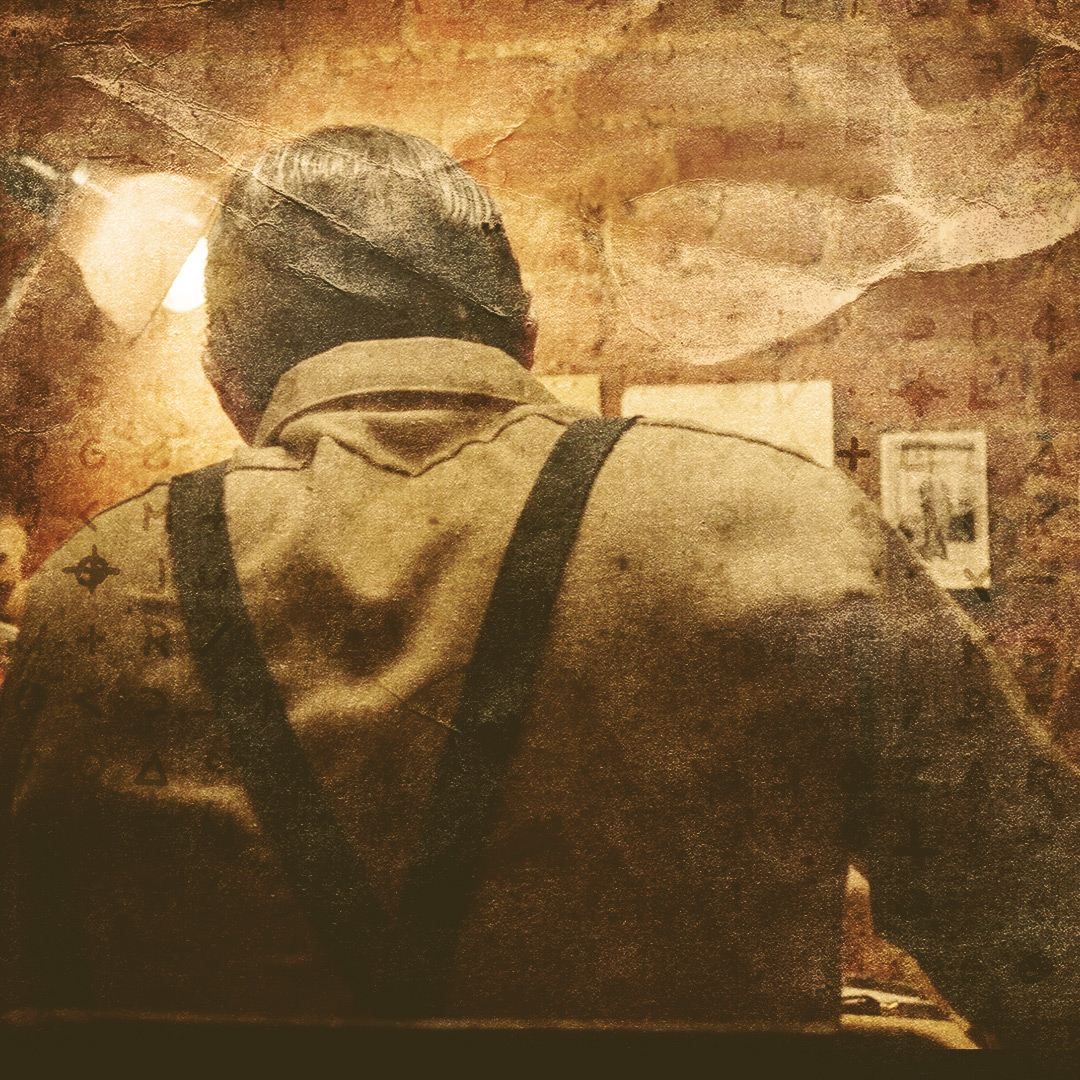
10 · Doubt
What if the story you’ve heard about the Zodiac is not the real story? It’s time to separate fact from fiction.
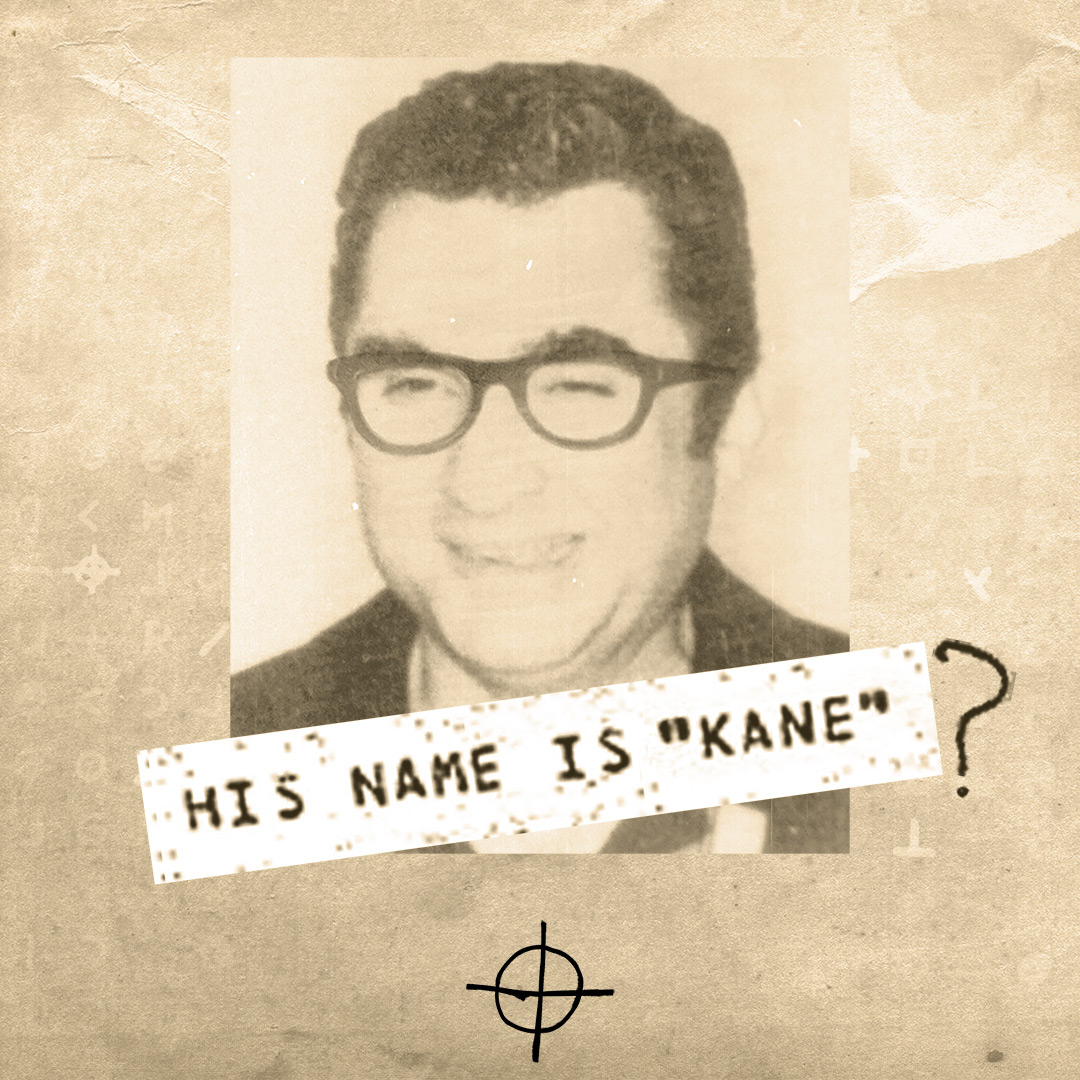
11 · Trails
Toschi’s investigation led to a dead end, but independent investigators are chasing down other leads.
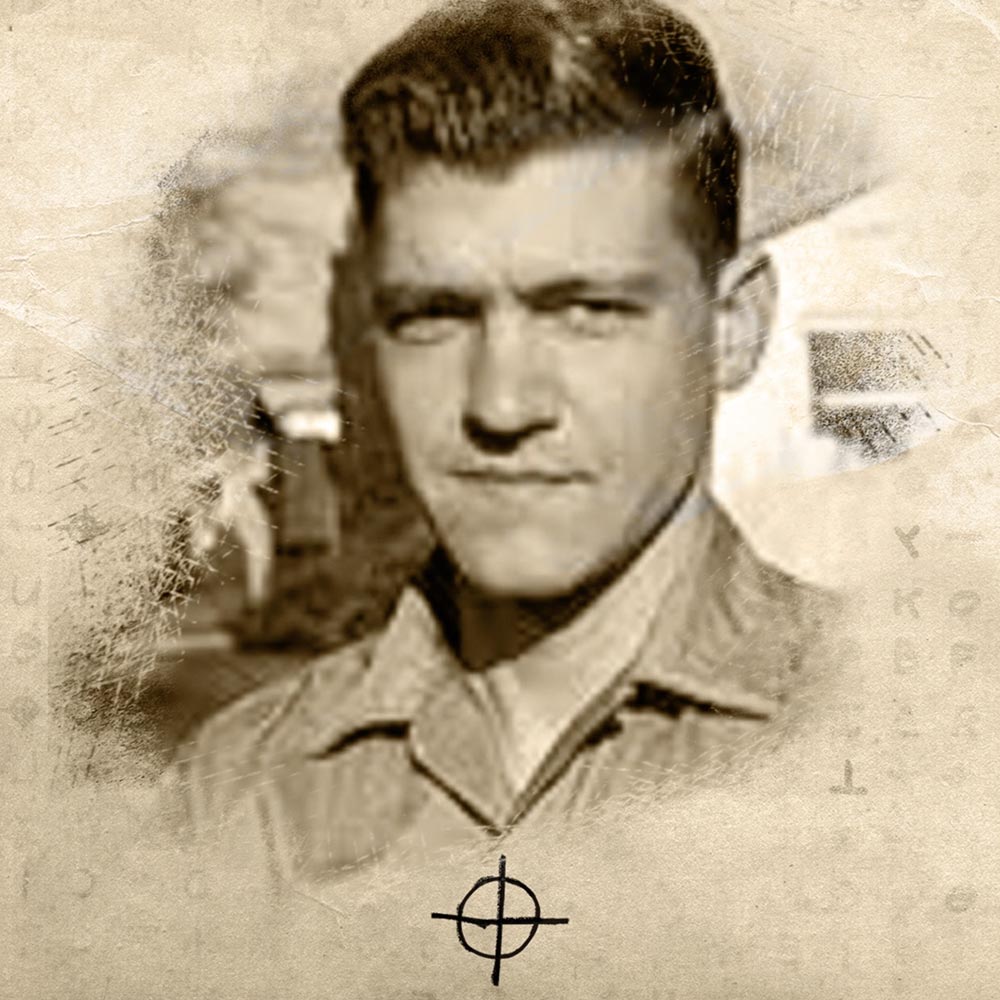
12 · Rabbit Holes
New theories bring new suspects. But for many independent investigators, those theories are truth.
